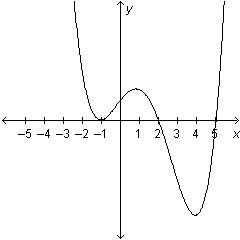|
|
|
1.
|
Complete the table. 
|
|
|
2.
|
Which is a graph of an even function with a positive leading
coefficient?
|
|
|
3.
|
Given  , which of the following is true?
|
|
|
4.
|
Which is the graph of the polynomial function  ?
|
|
|
5.
|
Subtract.  – 
|
|
|
6.
|
Multiply. 
|
|
|
7.
|
Write an equivalent expression for  .
|
|
|
8.
|
Use Pascal’s Triangle to expand the expression  .
|
|
|
9.
|
Divide  by  .
|
|
|
10.
|
Which divisor of  results in a remainder of 86?
|
|
|
11.
|
Which of the following is a factor of  ?
|
|
|
12.
|
Factor  .
|
|
|
13.
|
Factor the polynomial  completely.
|
|
|
14.
|
Solve the polynomial equation  by factoring. a. | The roots are 0, –1, and –6. | c. | The roots are 2 and
12. | b. | The roots are 0, 1, and 6. | d. | The roots are –1 and –6. |
|
|
|
15.
|
Which is a list of all the possible rational roots of  ?
|
|
|
16.
|
What is the degree of the simplest polynomial with integer coefficients that has
 , 2,  , and  as some of its zeros?
|
|
|
17.
|
Use the corollary of the fundamental theorem of algebra to find the number of
complex roots for each polynomial. | a.
|  | 1 | 2 | 3 | 4 | | b. |  | 1 | 2 | 3 | 4 | | c. |  | 1 | 2 | 3 | 4 | | d. |  | 1 | 2 | 3 | 4 | | | | | | |
|
|
|
18.
|
How can you write  as the difference of two squares?
|
|
|
19.
|
Describe the transformation of  represented by  . a. | The graph of g is a horizontal stretch by a factor of 2 and a translation 3
units right and 3 units up of the graph of f. | b. | The graph of g is a vertical stretch by
a factor of 2 and a translation 3 units left and 3 units up of the graph of f.
| c. | The graph of g is a vertical shrink by a factor of  and a
translation 3 units right and 3 units up of the graph of f. and a
translation 3 units right and 3 units up of the graph of f. | d. | The graph of
g is a vertical stretch by a factor of 2 and a translation 3 units right and 3 units up of the
graph of f. |
|
|
|
20.
|
Write a function that transforms  in the following
way: vertical stretch by a factor of 4 and shift 4 units left.
|
|
|
21.
|
Which of the following polynomial functions could have the graph
shown? 
|
|
|
22.
|
Explain how you can use transformations to determine whether the function  is even, odd, or neither.
|
|
|
23.
|
In the table, x represents the number of years a company has been in
business and y represents the number of employees that the company has. Find a polynomial
model for the data. Use the model to estimate the number of employees in year 9. | x | 1 | 2 | 3 | 4 | 5 | 6 | 7 | 8 | | y | 18 | 28 | 32 | 34 | 36 | 45 | 55 | 65 | | | | | | | | | |
|